 Research Article
Research Article
Improving Carbon Sequestration, Climate Resilience and Increasing the Productivity of Farms using Nature Based Solutions: The Case of Salvation Farming Solutions
Leonard Sonnenschein* and Tiberious Etyang
The Sonnenschein Institute, 6617 NW 24th Ave. Boca Raton, Florida 33496 USA
Corresponding AuthorLeonard Sonnenschein, The Sonnenschein Institute, 6617 NW 24th Ave. Boca Raton, Florida 33496 USA.
Received Date:September 11, 2023; Published Date:October 09, 2023
Abstract
Global population growth is putting pressure on nature. Resources that are vital for human activities such as healthy soil for food production and clean water are becoming scarce. The world’s agricultural land has become severely degraded rendering it unproductive and forcing farmers to abandon it. In Agriculture, Nature based solutions are considered long term beneficial environmentally, cost efficient and effective approaches in addressing sustainable land resource management, water quality and adaptation to climate change and is key in improving food security by increasing land ecosystem sustainability and productivity. This report is a comparison of 10+ years of maize research carried out in three different farming systems globally including India, America and Africa. Two studies were done in India in 2017 and 2018, three studies in the United States in 2014, 2020 and 2022 while in Africa two studies were done in Kenya and Zambia in 2023. Salvation Farming Solutions (SFS) has developed a line of nature based, non-GMO cropping solutions (patents pending) focused on smallholder farmers designed to disrupt the global agricultural industry by improving water availability/quality, detoxifying and increasing soil fertility, significantly improving crop production and improving the nutritional density of the food produced. The goal of the program is to provide Smallholder farmers with regenerative solutions that are nature-based technologies which improve carbon sequestration, climate resilience and increase the productivity of farms. Key findings from these researches demonstrate that maize crop productivity can be significantly enhanced in soils that have not been intensively farmed most likely due to the biome vitality of the soil enhanced through nature-based solutions to improve moisture, nutrient availability, and stimulate carbon sequestration and nitrogen fixation. Soils that have been intensively farmed such as in the United States seem to be less productive on an acre-to-acre comparative basis most likely due to non-regenerative approaches which are common for large scale farming. Nature-based agricultural solutions can provide small holder farmers significant financial benefits and provide consumers with more nutritious foods.
Keywords:Carbon sequestration; Climate resilience; Nature based solutions; Land ecosystem sustainability; Smallholder farmers; Crop productivity; Soil fertility; Nutritional density; Global Population growth; Food production; Regenerative solutions; Biome vitality; Nitrogen fixation; non-regenerative approaches; Water availability; Water quality
Introduction
Global population growth is putting pressure on nature. Resources that are vital for human activities such as healthy soil for food production and clean water are becoming scarce [1]. According to FAO report from almost 10 years ago, [2], already 52% of the world’s agricultural land was severely degraded rendering it unproductive and forcing farmers to abandon it. According to World Bank [3] demand for food globally is expected to increase by 50% by the year 2050 and about 50% of the population in Sub Saharan Africa (SSA) is vulnerable to extreme events, particularly climate change, which is mainly manifested through drought and flood [4]. A study carried out in 2016 by the World Bank indicated that the agriculture sector contributed a source of living to 65% of the poor working adults. This illustrated the key role that agriculture holds for the livelihoods of people and the need for its development being important tool in reducing poverty [5]. Land degradation coupled with increased demand on the food system and increasing risk of climate change has triggered public interest to move from conventional, high-input-driven farming to nature-based solutions in Agriculture [6-8].
Nature Based Solutions in Agriculture
In Agriculture, Nature based solutions (Nbs) are considered more long term beneficial environmentally, cost efficient and effective approaches in addressing sustainable land resource management and climate change [8,9]. Such practices improve water availability; restore ecosystems and soil health that is significant in improving food security by increasing land ecosystem production and productivity [10]. The benefits associated with the use of nature-based solutions include climate change adaptation and disaster risk reduction, climate change mitigation potential, provision of non–carbon ecosystem services, resource use efficiency without the use of mineral fertilizer and other external inputs, food security and income generation, and social benefits [11]. Nature based solutions can help farming communities establish a resilient food production to future weather extremes by improving soil health and water retention, enhanced food and nutrition security. They can reduce the use of chemical additives, which reduces production costs and creates safe foods [11]. Nature based solutions can play a critical role in mitigating climate change by reducing carbon emission from food sector by enhancing carbon sequestration and ways that enhance the carbon retained in plants and soils [12]. Studies by FAO show that Nature Based solutions can provide 37% of climate change mitigation until 2030 and 20% between now and 2050 [2]. Nature based solutions can further enhance ecosystem and species by improving habitat diversity while enhancing quality and reliability of water [8].
Nature Based Solutions in Food systems transformation
According to the Food and Land Use Coalition’s Growing Better report [13], 3 out of 10 scientific evidences and economic cases critical for food systems transformations are nature-based solution- that, by 2030, could help bring climate change under control, ensure healthy diets for all, improve food security and create a more inclusive rural economies thus vital in establishing a sustainable future for food [1]. For a sustainable future food system, agricultural production should transition production approaches that restore nature and regenerative.
Nature based solutions in agriculture can combine climate change mitigation, biodiversity conservation, adaptation, sustainable resource management and disaster risk reduction in the fight against climate change through the preservation of biodiversity and carbon sink [12]. Nature based solutions are initiatives focused on ecosystem health whose actions aim to restore, protect and sustainably manage modified or natural ecosystems while addressing social challenges and promoting benefits for human and biodiversity [14]. They are designed to improve ecosystem services provided by nature. In agriculture, it can restore degraded land, increase crop productivity, resilience and improve carbon sequestration [8].
Nature based solutions for healthy ecosystem
According to Seddon et al [15], Nature based solution lead to a healthy ecosystem that is more resilient. It further increases soil health, nutrient availability, water retention, soil biodiversity and reduce soil degradation thus increase crop productivity with lesser chemical additives used creating a safer and more nutritious food [16]. According to Pearson [17], an increase in diversity above ground improves below ground biodiversity which immensely contributes to nitrogen fixation, nutrient cycling with ability to regulate the dynamics of greenhouse gas emission effects and soil carbon sequestration, effects on soil physical structure and water regimes with significantly positive effect on plant health [6,18,19]. Sonnenschein et al [16] reported that agricultural sector is primarily responsible for excess nitrogen in the form of ammonia, nitrite and nitrate, phosphorus, pesticides, and pathogen pollution of water bodies in agricultural zones. Nitrogen and phosphorous are causal to eutrophication in water bodies and affecting aquatic life [20]. Nature-based Solutions (NBSs) can be a valuable option for intercepting and treating various streams of nutrient pollution from agriculture [21].
Nature-based Solution for Nutrition and Human Hea
According to the UN Food and Agriculture Organization (FAO) and The Nature Conservancy (TNC) ; (2023), nature –based solutions have the potential in agricultural production systems to address the nutritional need for people globally while restoring nature and the climate thus contribute to the 2030 Sustainable development agenda. The transition among the global producers to a nature-positive, regenerative food system requires the finance, policy and science [9].
Nature-based Solution for Food and Nutrition Security
According to UN-OCHA [22] report, Household production was worsened by the COVID-19 which also affected access to safe and nutritious food, hence threatening food systems already impacted by pre-existing or seasonal threats and vulnerabilities such as natural hazards, pests, armed conflicts and violence [23,24]. Extreme weather conditions have been triggered by climate change which has resulted in extended drought periods mostly followed by heavy rains and storms that end up ravaging crop production leaving smallholder farmers with no food for the household or to be able to sell for the household income. It has been shown that climate change has reduced the food supplies when crop yields is usually transformed into consumable calories on people’s plates [25].
Background of the Reported Studies
In this report, we are going to compare different studies carried out in three different farming systems globally including India, North America and Africa. Two studies were done in India in 2017 and 2018, three studies in the United States in 2014, 2020 and 2022 covering both residential community farms trials in Missouri, large scale Commercial farm trials in South Dakota and Illinois while some studies were done in a golf course and highly saline wheat fields in California while in Africa two studies were done in Kenya and Zambia in 2023. The results are from the studies that have been carried out across the globe with Salvation Farming Solutions products. Salvation Farming Solutions (SFS) has developed a line of nature based, non-GMO cropping solutions (patents pending) focused on smallholder farmers designed to disrupt the global agricultural industry by improving water availability/quality, detoxifying and increasing soil fertility, significantly improving crop production and improving the nutritional density of the food produced! This model relates to incorporating new ways to use natural means to remediate toxic soils using safe natural organic products that use geologic chemical binding processes that increase soil organic carbon content, soil health, improves drought resistance, removes and binds the toxic chemicals which prevent adsorption by the plants or into the crop while also rendering the toxic chemicals inert. It also improves the condition of the soil to a degree that draws and attracts worms; the earth’s natural aeration and fertilizer system. The primary mission is to eradicate food security challenges while empowering smallholder farmers with cropping system that delivers greater production and generational regenerative enhancement of the soil. SFS ultimately provides Smallholder farmers with regenerative solutions that are naturebased technologies which improve carbon sequestration, climate resilience and increase the productivity of farms. The solutions are highly sustainable, multi-generationally impactful; changing cropping practices – A Historic Agricultural and Economic Legacy for the World.
India Studies
There were two studies carried out in India in 2017 and 2018.
Independent Evaluation by eKutir Rural Management Services for Corn Production in 2017, in Odisha India
An agricultural field trial was conducted by eKutir in 2017 in Odisha India with World Aquarium’s Conservation Foundation, to test the efficacy of sustainable agriculture products offered to increase crop production, increase nutritional density and produce stronger, more resilient plants. A sweet corn crop was planted with Control, Seed Treatment only, and Seed Treatment and Fertilizer Treatment combined; in addition, a soil detox was used on the Treated crops and not the Control. Seeds used for the field trial were Advanta PAC 712 Hybrid Corn.
Over the course of the trial the following results we noted:
1. The planting was done in below average soil without
erosion control, mulch, compost or crop rotation; therefore
the expectation was low crop production and low nutritional
density results;
2. The control plants showed strong infestation of corn
pests, the corn borer pests, and the Treated crops showed no
infestation.
3. No irrigation was in place therefore plants were subject to
the stress of heavy rains and periods of non-optimal dryness;
4. This location suffers from top soil runoff and a lack of crop
rotation in addition to the challenges of climate change such as
warmer weather and longer dry periods of time;
5. The Treated seeds produced plants that grew significantly
higher (~1.5X higher) and much faster compared to Control
seed group with no Treatment;
6. Crop production was dramatically increased from the
Seed Treatment + Fertilizer Treatment combined: an increase
in crop production of 3-4 cobs per stalk compared to control
production of 1-2 cobs per stalk.
7. Nutritional analyses done in December, 2017 by
International Crops Research Institute for the Semi-Arid
Tropics (ICRISAT) which is an international organization which
conducts agricultural research for rural development and is
chartered by UN and FAO showed g/100g percentage change of
400%, 374% and 257% for protein, carbs and fat respectively.
Previous Seed Pretreatment independent research has proved to offset lack of nutrition due to increased growth from CO2 abundance to improve nutritional density of crops including: significant increase in Protein (Figure 2), Carbohydrates (Figure 3), Fat (Figure 4), and along with significant overall production increases (Figure 1). Additionally, seed pretreatment has shown effectiveness in preventing pest infestations.
There was 66% increase in yield with use of Seed Treatments with no fertilizer while use of seed treatment with reduced fertilizer resulted in 125% increase in yield as compared to control as shown in figure 1.
Seed treatment led to over 400% increase in protein content in the corn as shown in Figure 2.
The application of seed treatment led to 374% increase in carbohydrates level in maize as compared to control as shown in Figure 3.
Seed treatment was demonstrated to increase the fat concentration in Maize by 257% as compared to control as shown in Figure 4.


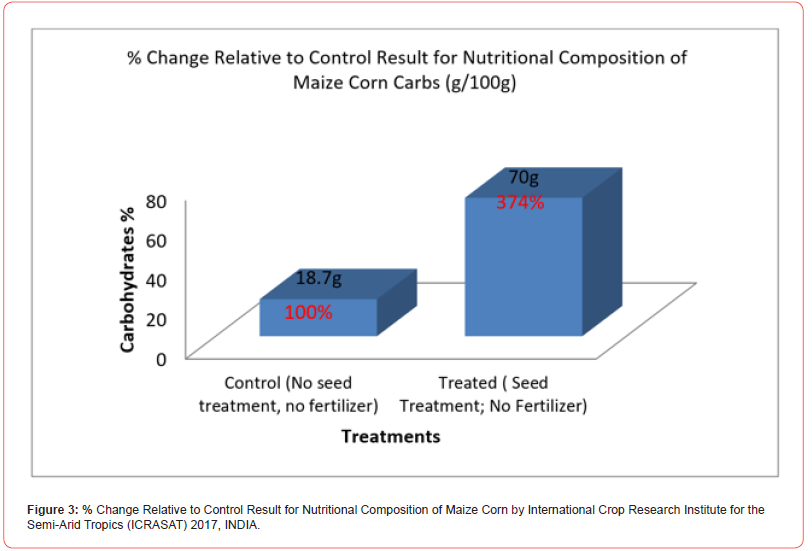
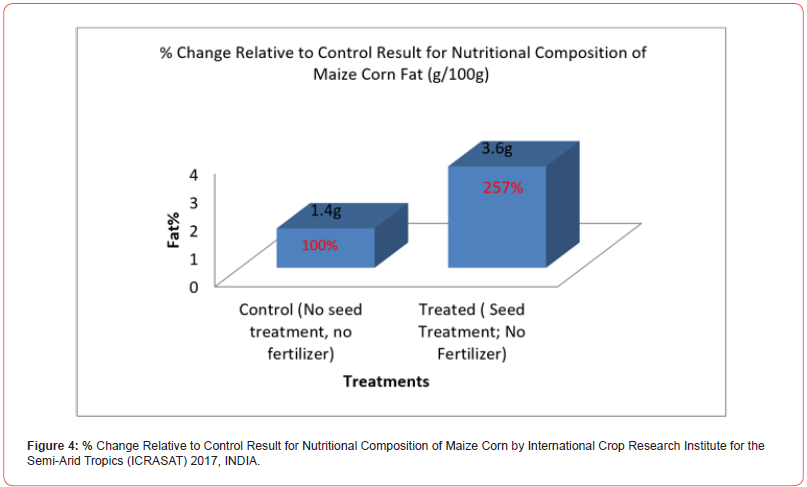
Sustainable Agriculture Trials – Maize Project, India 2018
A maize Demonstration Farm was established at Narayankhed, in the Sangareddy District of Telangana State of India in conjunction with the Saral Jeevan India Foundation from July to October 2018 as part of the “Sustainable Agriculture Trials – Maize” project. Two paid host farmers were actively involved in all the operations that were carried out in the farm. The demonstration Farm was established to exhibit to farmers the best technologies locally available in maize production, provide a learning platform for farmers to apply these technologies on their farms, interact with farmers and select them for the Regional Economics Agricultural and Community Help (REACH) program. It is through this mission that goals to empower local farmers in groups becomes the base for a farm-to-table solution that will benefit each level of the value chain as it currently exists as the core of the sustainable business proposition for Salvation Farming Solutions. The demonstration farm was further used to test the Sustainable Corn Program naturebased seed, soil and fertilizer treatment solutions marketed by Salvation Farming Solutions in the local field location.
Materials: The treatments available included:
• Soil Detox treatment supplied as a liquid concentrate that
is mixed with water and sprayed on the field to be treated.
• Seed Soak Treatment supplied as a powder mix to be
added with a liquid catalyst to a bucket of water. The seeds are
soaked in 5-gallon bucket overnight.
• Seed Powder Treatment is a dry mix put in bag with seeds
with a liquid catalyst and shaken to cover the corn kernels with
powder.
• Fertilizer Treatment is a powder mix that is mixed into
fertilizer to improve fertilizer and can reduce fertilizer used by
80% or more.
• Natural Pesticide is a multipart liquid mix diluted with
water that is applied as a spray only if pests appear on the crop.
Plot was planted in sandy red soil with no irrigation used for crop watering, expected monsoon rains were the only source of water for maize crop. The only heavy rain was 2 days before planting and 10 days after planting otherwise only a few short showers; crops faced extreme drought conditions.
The field trial procedure: The Farm, under the overall
coordination of Saral Jeevan India Foundation staff. The
establishment of the Demonstration Farm was part of a Trainer
of Trainers for Farmer Field Schools. The selected farmers were
allowed to use their regular seeds and their practices for planting
but just before the sowing few extra activities were carried out
during the pilot process:
1. After tilling Soil Detox solution was sprayed in the selected
treatment area.
2. Seeds were treated with the recommended solutions:
• Seeds in one part were soaked in the recommended
solution for 24 hours before the sowing;
• Seeds in the second part were applied with powder
coating.
3. Application of fertilizer advised and made sure that at least
75% less was applied in the treatment area.
4. No pesticides and herbicides were used.
Land Preparation and Planting: Land clearing using manual labor was done and the weeds were collected and field layout was done.
The field was ploughed in the presence of the selected farmers for joint learning. Planting was done on July 15, 2018 at the period when groundwater and soil temperature were suitable. Planting was scheduled such that the heat and water sensitive growth stage of maize (i.e., the flowering stage) did not coincide with the period of drought.
Planting depth of maize varied from 5 to 10 cm, depending on the soil type and planting date. As a rule, planting should be shallower in heavier soils than in sandy soils. Planting was done by the participating local farmers as shown in Figure 5 who were selected for joint learning so that they would apply the technologies on their respective farms.

Results from the field trial in India 2018: After 60 days the
treated crops caught up on growth and significantly increased
production. Control maize was ready for harvest at week 14
whereas treated plants were ready for harvest at week 10 (one
month earlier).
• Compared by weights to control maize; Powder treated
maize increased crop production by 290% whereas Seed Soak
treated maize increased crop production by 200%.
• In terms of increase in maize plant biomass by volumes
compared to control; Powder treated maize increased biomass
crop production by 210% (p<0.0001) while Seed Soak treated
maize increased biomass crop production by 142% (p<0.001).
This biomass increase indicates higher carbon sequestration
from carbon farming and potential applications for mulch,
compost and green fodder or other uses.
• Compared to control; Powder treated maize roots
were 214% (p<0.0001) larger than controls at mid-crop
measurement; while Soak treated maize roots were 228%
(p<0.0001) larger than controls at mid-crop measurement.
These larger root measurements indicate the potential for
higher plant resiliency to drought, plant strength and higher
biomass growth, and the potential for increased nutrient
uptake from the soil.
• The treated soil appeared darker, indicating greater soil
microbial life and greater retention of water. Farmers also
noticed treated maize leaves were noticeably brighter and
larger than control group.
• When looking at cost savings from Field Trial products;
there was 75% fertilizer use reduction and no herbicide or
pesticide was used. This translates up to 5 times the actual
costs of production. Conversely for the 75% fertilizer use and
no herbicide or pesticide used translates to 80% saving in farm
inputs. Control group was treated with 100% fertilizer.
• No pests or diseases were found on treated corn groups
(Powder and Soak); beneficial red beetles also were found
on treated corn and not on control corn. Control group was
infested with pests and affected by maize mycotoxin.
• Harvested treated corn tasted softer and “tastier” in flavor
compared to Control corn.
• Soaked and Powder treated maize plants were ready for
harvest 25% time earlier (week 10-11 versus week 14) than
Control, indicating the potential for additional second or third
cropping production in relevant regions along with better
opportunities for market pricing.
• Good agricultural practices were carried out on the farm
with the participating farmers resulting in maximum crop
growth and development
Discussion of India Study: These increases in nutritional density coupled with more than double growth rates using 100% natural and organic solutions can be quite competitive compared to present commercial farm conditions. Benefits of this system can reduce fertilizer use by up to 80%. Overall costs for this increased production may be up to 50% savings for the farmers with doubling crop production with potential to quadruple income. This economic value will be further driven by demand for this better tasting, healthier corn. The field that was used for the trial was later discovered to be a tract of unproductive land that locals were unwilling to grow maize on. However, through the efforts of the participating farmers and the Agriculture Extension Officer, a healthy crop with appreciable yield was obtained. The key lessons learned were that farming in dry lands was very challenging especially erratic rainfall during crucial crop growth stages such as sprouting and cob development. The lack of rainfall can result to total crop failure or losses to farmers. The Soaked seeds were able to withstand the drought well and sprouted well in time but Powder coated seeds withstood the drought very well and gave good yield.
Conclusion from India Study: Both the Powder and Soak Treatments increased productivity significantly (Powder 290%, Soak 200% respectively) compared to the Control Group under drought conditions and significantly increased stalk and root (silage production) size (Powder 210%, Soak 142% respectively). Secondarily, the improved flavor, pest and disease resistance provided by the treatments, even without pesticides will prove of value for future farmer and consumer adoptions of this innovative and novel treatment program. Given the significant farmer cost savings and improved production output with this program it is recommended that Market Demonstrations be pursued to make these solutions more available for smallholder farmers as climate resilient options for improved food security and economic development for the sector.
Overall, the farmers were very appreciative of the training given to them by the project. They, however, emphasized the need for the development of sustainable maize postharvest management system in Telangana with focus on efficient storage and marketing to enable maize farmers obtain good prices for their produce. As we make progress towards achieving the United Nations Sustainable Development Goals focus needs to be on game changing processes rather than business as usual with government support needed to be front and center for these new ways forward.
It is clear that we are what we eat and that our health is directly related to our nutrition [16]. We believe that consumption of the Salvation Farming Solutions treated corn will promote better community health and well-being just by the nature of consumption. Medical studies are planned in order to fully maximize and understand the health benefits of these technologically improved plants and seeds.
The United States Studies
The studies carried out in the United States covered both residential community farms trials in Missouri, large scale Commercial farm trials in South Dakota and Illinois while some studies were done in a golf course and highly saline wheat fields in California as reported below.
Missouri USA 2014
A study was commissioned in a residential community farm in 2014 to evaluate the efficacy of SFS products. The results are as follows.
Seed treatment with reduced fertilizer led to a 274% increase in Fat in Maize as compared to control as shown in Figure 6.
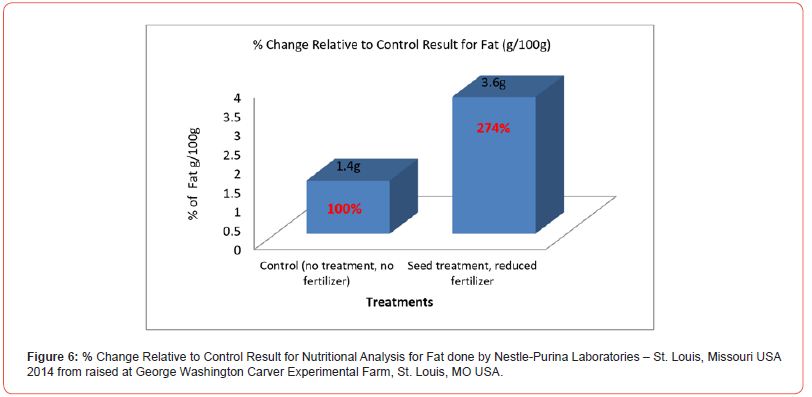
When looking at protein levels of Maize, seed treatment with standard fertilizer led to 8% increase in Protein levels while seed treatment with no fertilizer led to 16% increase in proteins as compared to control (no seed treatment, no fertilizer) case as shown in Figure 7.
Niacin level more than tripled with seed treatment without fertilizer treatment (337% increase) as compared to control while seed treatment with standard fertilizer led to a 521% increase in Niacin levels as shown in Figure 8 when compared to control (no seed treatment, no fertilizer).
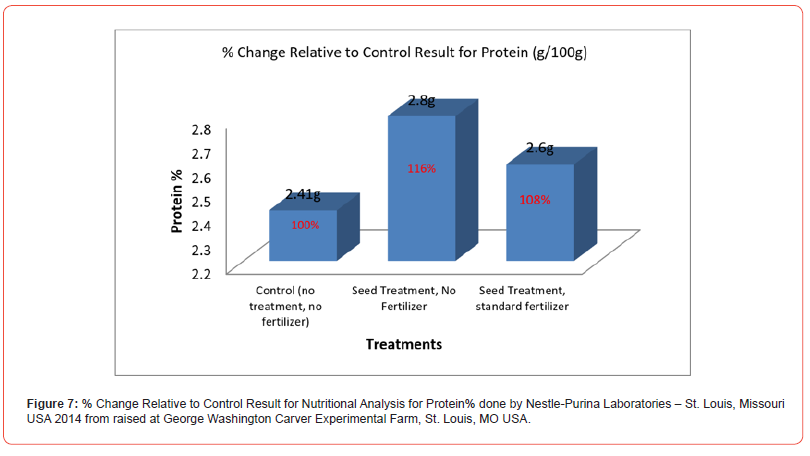
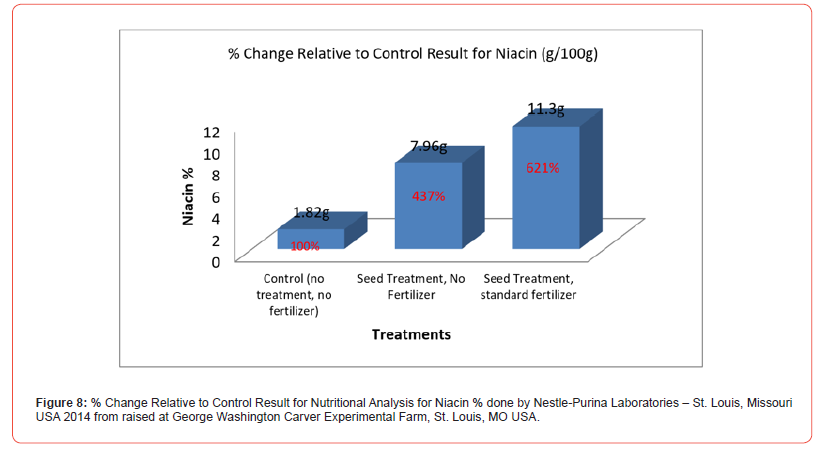
South Dakota Studies, 2020
The study was done on 3000 acres Carper Farms during the spring of 2020.
Key Findings for the Carper Farms Corn Tests:
• There was 37% yield increase in the SFS Treated Field
with an 80% reduction of fertilizer use as compared to the
100% fertilizer use in the Control Fields with No SFS Treatment
• Corn ears for 20% fertilizer-SFS treated group were
32% larger than 100% fertilizer group with p<0.05 hence
statistically significant.
• Minimally, this process can significantly reduce the
planting cost and increased production.
• Soil moisture is increased by 50% or more which allows
a 50% or greater savings in water use while also significantly
improving the soil quality.
• Additionally, it was noted that the 20% SFS Treated Fields
matured almost two weeks earlier than the 100% Fertilizer
Control Fields.
• There was 77% more corn produced with the 80%fertilizer
reduction SFS Treated Fields as compared to the SFS Treated
0% fertilizer use Field
• The results of the soil analysis are shown in Table 1
where significant changes were noted for Nitrogen, Sulfur,
Iron, Manganese, Carbonate, Soluble Salts and Cation Exchange
Capacity (CEC).
Table 1:Increase/Decrease Relative to Control for Carper Farms Soil Analysis.
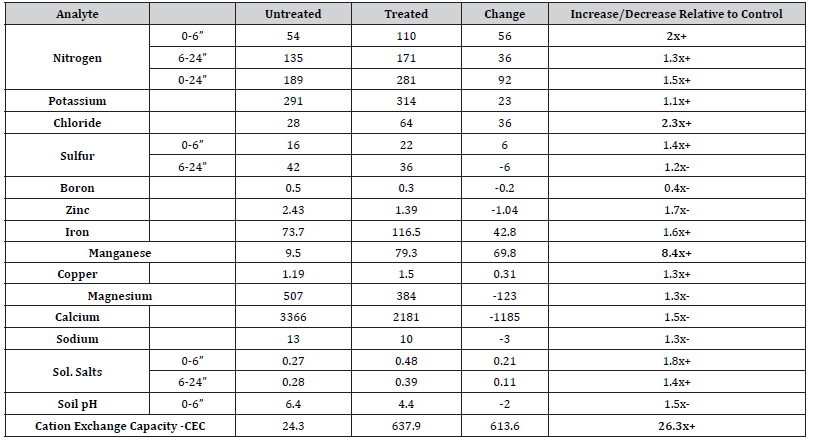
Analysis done by Agvise Laboratories, 5/29/2020
Nutritional Analysis Results: From the nutritional analysis done by Nestle-Purina Laboratories –St Louis, MO in the summer 2020, it was noted that the moisture content was slightly higher in all groups for earlier planting. Fat content was significantly higher in 0% (+64%) and 20% (+20%) Fertilizer with Seed Treatment compared to same without Seed Treatment. Seed Treatment also increased protein content. Fiber content with SFS Seed Treatment compared to SFS Soil & Fertilizer -41%. Ash content was lower in all groups in later harvest groups up to -73%. SFS Seed Treatment with Soil and Fertilizer Amendment Treatments increased Niacin levels as compared to 100% Fertilizer alone by up to +25%. Seed Treatment alone compared to SFS Soil and Fertilizer Amendment accounted for a 15x increase in Niacin for the 0% Fertilizer group comparison. Seed Treatment alone compared to SFS Soil and Fertilizer Amendment accounted for a 44% increase in Niacin for the 20% Fertilizer group comparison. Corn in the later harvest was significantly higher in carbohydrates (sweeter). Corn in the 0% Fertilizer with Seed Treatment and SFS Soil and Fertilizer Amendment group compared to the same group with no seed treatment had +22% more calories. Overall, Seed Treatment with Soil and Fertilizer Amendments significantly enhanced corn nutritional values more than Soil and Fertilizer treatments alone with the same or better nutritional values with the 100% Fertilizer.
California 2021
Two studies were implemented in California. One on a golf course field while the other was done on a highly saline wheat field. The soil analysis was done comparing the results before and after treatment.
Soil Analysis results for a Golf Course Field in California 12/21/2021: As shown in Table 2, significant changes were noted in the levels of Nitrate, Soil Organic Matter, Moisture levels, Chloride, Sulfate, Total dissolved solids, Boron and Magnesium when comparing treated and untreated soil samples.
Table 2:Increase/Decrease Relative to Control for Soil Analysis on a golf Course field in California comparing SFS Treated and Untreated soils on 12/21/2021.
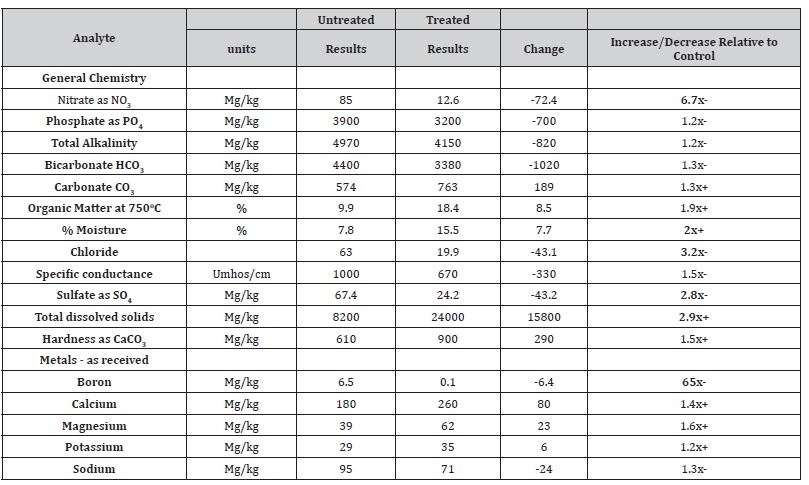
Soil Analysis results for a highly Saline Wheat Field in California 3/30/2022: Based upon a highly saline wheat field, application of SFS treatments had significant changes in the levels of Nitrate, Total Alkalinity, Bicarbonate, Chloride, Sulfate, Calcium, Magnesium, and Sodium as shown in Table 3. No significant change in Organic Matter was observed under the saline conditions due to lack of life in the soils.
Table 3:Increase/Decrease Relative to Control for a highly Saline Wheat Field in California 3/30/2022.
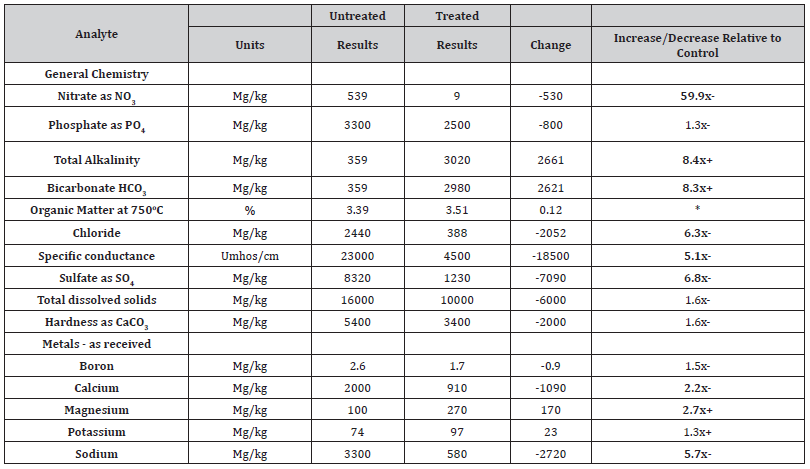
*No change
Illinois Study, 2022

This study was done on an 8,000-acre commercial farm in Illinois in 2022. The results indicate that application of SFS products led to 18% increase in yield as compared to control (no SFS treatment) as shown in Figure 9.
Zambia Study 2023
A Maize on-station demonstration field was established at Zambia Agricultural Research Institute (ZARI) in Kabwe, Zambia in February 2023. The project aimed to provide smallholder farmers with regenerative solutions that are nature-based technologies that improve carbon sequestration, climate resilience and increase the productivity of farms in Zambia through the introduction of Salvation Farming Solutions (SFS) methods. The SFS method consists of Soil and Fertilizer treatment, Seed powder treatment, and Organic pesticide.
Description of the study site: The study was carried out at Kabwe Research Station (KRS) situated in Kabwe District of Zambia. KRS is approximately 142km from Zambia’s Capital City, Lusaka, along the Great North Road. The station lies between latitudes -14.3954 and longitude 28.4934, with a gross area of over 500 ha. The area receives rainfall of between 800-1000 mm per annum with temperatures ranging between 20 to 34°C. According to ZARI [26] and Burke et al. [27], the soils in Kabwe are mostly Haplic Lixisols and Luvisols.
Experimental Design: A type 1 randomized complete block
design (RCBD) experiment with a split-split plot treatment
structure with three replications was used in the experiment. The
test crop was Maize (Zea Mays) as sole crop. The selected treatments
comprised of 3 (three) main plots composed of no chemical fertilizer
(Nil Fertilizer), 20% of Full rate fertilizer application (80% less of
the fertilizer use recommendation for Maize in Kabwe) and Full
Rate fertilizer application (200kg ha-1 Basal and 200kg ha-1 for top
dressing, =100% of the fertilizer use recommendation for Maize in
Kabwe) which were designated as main plots. The main plot size
was 12.25mx15m. Eight Sub plot factors composed of Salvation
Farming Solutions (SFS) Nature Based solutions and included two
sub plots with No SFS treatments, two with SFS Seed Treatments,
two with SFS Soil and Fertilizer Treatment, and two with SFS Seed
treatment with Soil and Fertilizer treatment. The sub-plot size
was 5.9mx3m. The treatments were replicated three times in the
experimental field. Inorganic fertilizer was applied in designated
sub plots (Nil, 20% and 100% rates), followed by seeds and then
sprayed with soil and fertilizer treatment.
a) SFS Field protocol: Each SFS TRIAL Kit provided enough
sample products for Maize growth evaluation for 1+ acre of
land. The SFS TRIAL Kit included the seed, soil and fertilizer
treatments.
b) Seed Treatment Powder preparation: Maize Seeds to
be planted was added into 20litres bucket. All the contents
in the seed treatment powder were sprinkled into the bucket
with seeds. A cup of treated water was added into the bucket
containing seeds and the seed treatment. The content was
mixed with wooden spoon. The bucket contents were stirred
slowly until all the seeds were uniformly coated with the seed
treatment. The seeds were planted one hour after mixing.
c) Soil and Fertilizer Treatment Concentrate: A backpack
sprayer was filled with water, then a cup full bottle of the soil
and fertilizer treatment concentrate was added to the backpack.
An even moist was applied to the soil.
d) Field soil sampling and analysis: The zigzag sampling
framework was used to sample composited soils at plot level (0-
20cm depth) before planting, 9 weeks after planting and after
harvesting of the experiment for soil nutrient analysis following
the methods outlined in Okalebo et al [28]. To determine total
organic carbon (TOC), the soil sample was oxidized using
acidified dichromate at 150oC for 30 minutes followed by
calorimetric determination [28]. Nitrogen (N) was analyzed by
Kjeldahl method [29].
Results
Germination Rates
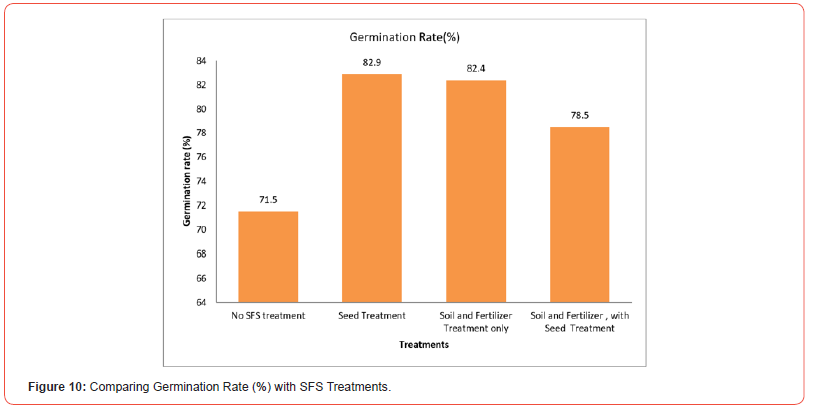
A statistically significant (p=0.028) difference was observed when comparing germination rates between fields with no SFS treatments versus those with Soil and Fertilizer, with Seed Treatments as shown in Figure 10.
Yield data
The seed, soil and fertilizer treatment increased yield for staple crops by up to 330% and reduce fertilizer by at least 80%.
Maize yield was very significantly affected by the SFS treatments With No chemical fertilizer used; Seed treatment increased yield by 288%, Soil and Fertilizer treatment increased yield by 234% while combination of Seed, Soil and Fertilizer treatments increased yield by 330% as shown in Figure 11. SFS treatments can at least double the yield with no fertilizer application.
There was 223% increase in yield with reduced fertilizer application (20% of Full rate) compared to no fertilizer while with full rate fertilizer application an increase of 246% was observed when Seed, Soil and Fertilizer treatments are applied for maize production as shown in Figure 12. This demonstrates that reduction in fertilizer used by farmers by up to 80% hence reduced production costs and soil toxicity making farming affordable to many farmers while significantly increasing the farmers’ economic position and making the soils healthier the subsequent cropping season.
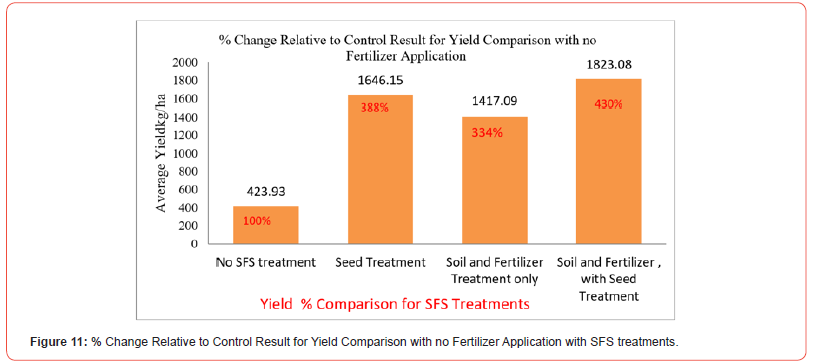
There was 430% increase in yield when using SFS treatments (seed, soil and fertilizer) as compared to control with no fertilizer used. With reduced fertilizer application, use of SFS treatment led to 1390% increase in yield as compared to control (no SFS treatment, no fertilizer application). Full rate fertilizer application with no SFS treatment led to 373% increase in yield as compared to control as shown in Figure 12. SFS treatment with full fertilizer application led to 1489% increase in yield as compared to control.
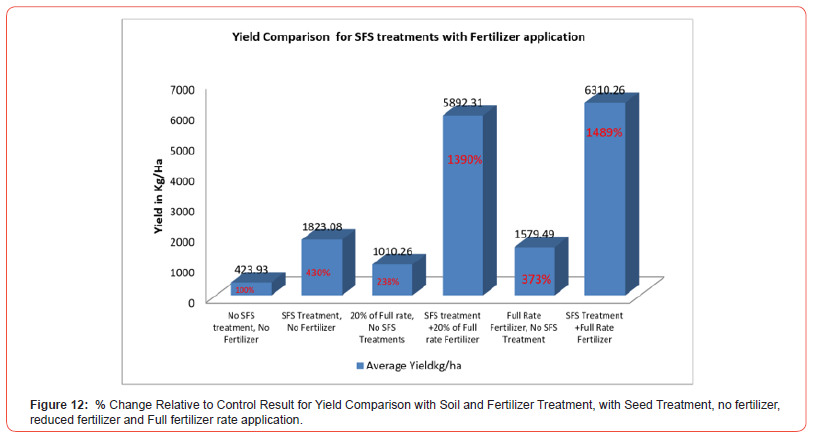
Soil Organic Carbon
Significant Soil Organic Carbon Sequestration with SFS treatments was observed as shown in Figure 13 which is significant in establishing a resilient food system for generational impact. Treatments with SFS Soil and Fertilizer treatments with Seed treatment led to higher changes in Soil Organic Carbon (SOC) while those without SFS led to least changes in SOC sequestration.
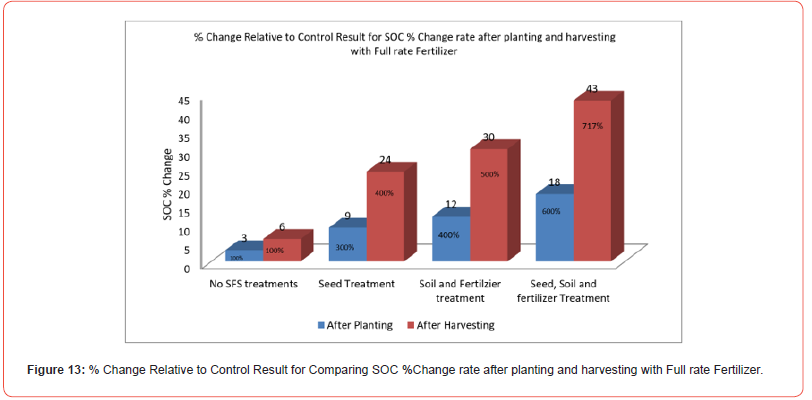
Soil Nitrogen
Soil Nitrogen percentage changes showed significant increase in natural nitrogen production influenced by SFS treatments as shown in Figure 14. Soil and fertilizer treatments with seed treatment contributed to the highest percentage increase in soil N, while Control (No SFS treatments) contributed to the least increase in soil N during the crop growth phase. Use of SFS treatments significantly improve soil health and nitrogen sequestration through a naturebased solution
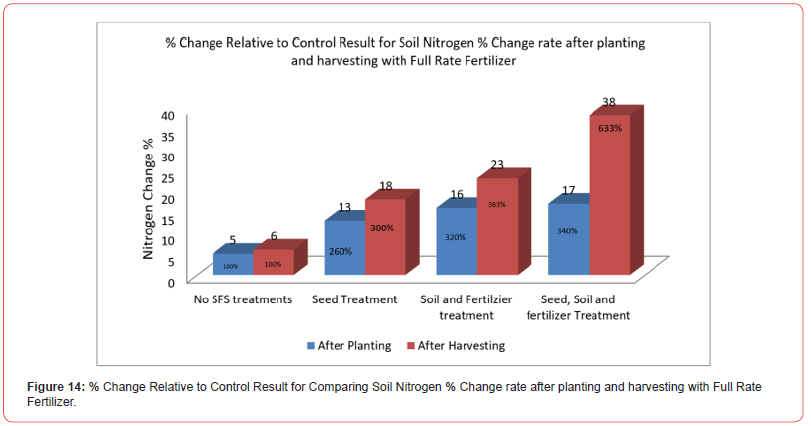
SFS benefits learned from studies in Zambia
SFS treatments can at least double the yield with no fertilizer application. The reduction in fertilizer used by farmers by up to 80% translates to reduced production costs and soil toxicity making farming more affordable to many farmers while significantly increasing the farmers’ economic position and making the soils healthier for the subsequent cropping season. The SFS Treatments significantly improves soil health and regenerative of soil conditions through a nature-based solution. Soil Carbon sequestrations reported indicated a possibility for establishing a significant resilient food system for generational impact. The SFS treatments substantially enhance production results; as much as 200% more in yield thus a profitable business venture that can attract investment. SFS treatments significantly improve soil health and nitrogen sequestrations thus demonstrate ability of farming to be climate resilient with its application.
Kenya Study
This study was set up in a farmer’s field in Onyunyur, Kakoli and Amagoro in Busia County, Western Kenya region. Three fields were treated with SFS products while one field was control (no SFS products were applied). Same maize variety was planted at the same time.
Nutritional Analysis
Maize grown under SFS treatment showed overall tremendous increase in nutritional value as shown in Table 4.
Table 4:Increase/Decrease Relative to Control for Nutritional Analysis for Maize grown under SFS in Busia County, Western Kenya.
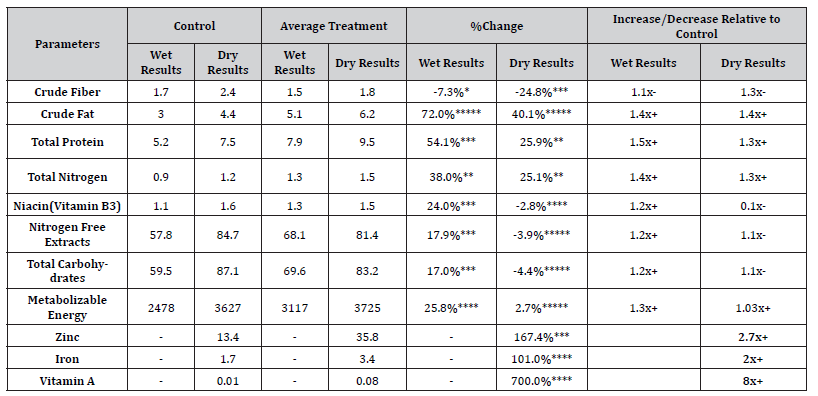
Analysis done by Spectra lab Analytical Services Ltd Nairobi Kenya, July 27, 2023 *, **, ***, **** and ***** means the statistical significance at p<0.2, p<0.05, p<0.01, p<0.001 and p<0.0001 respectively.
Key findings:
• Crude Fat showed extremely significant difference when
comparing maize treated with SFS and that without SFS
treatment
• There was a very significant difference in total protein
when comparing treated and untreated maize
• There was extremely significant difference in total
nitrogen
• Niacin (Vitamin B3) and Nitrogen free extracts showed
extreme significant result changes when SFS treated maize was
compared with untreated maize
• Metabolizable energy showed extremely significant
difference results changes when SFS treated maize was
compared with untreated maize
• Zinc, Iron and Vitamin A showed extremely significant
difference results changes when SFS treated maize was
compared with untreated dry maize
• The results show extremely significant changes in
nutritional value for the maize when comparing treated and
untreated maize. Maize grown under SFS treatment showed an
overall tremendous increase in nutritional value
• Improved nutritional values (increase of Fat by 72%,
Protein by 54.1%, Niacin (Vitamin B3) by 28.3%, Carbohydrates
by 25.9% while Metabolized Energy by 35.3%) hence that can
improve health benefits to the consumers leading to a healthier
community
Fortification
According to Mwai et al [30], in Kenya, compliance with food fortification standards is still low at 28% despite all the efforts put by both government and its partners. There is a need for concerted efforts to understand the main causes of the low compliance levels in order to develop targeted strategies for mitigation. According to East African Community, East African Standards; Micronutrient deficiencies in developing countries are widespread, particularly deficiencies of Iron, Vitamin A, Iodine, Folic acid and Zinc. The fortification compounds used for Vitamin B3 (Niacin), Iron and Zinc are Niacinamide, NaFeEDTA and Zinc Oxide respectively. From the Kenyan Study the nutrient levels of the above micronutrient were near or above the minimum requirements hence meeting the threshold for the fortification and better alternative to using the chemical fortification compounds because of bioavailability of the nutrients to the consumer using nature-based solutions.
Discussion
Yield change comparisons
Uses of SFS products have been demonstrated to have significant impact on the maize yield. When looking across the three farming systems, there was larger impact in the yield in Zambia and India as compared to the commercial farm in South Dakota as shown in Table 5.
Table 5:% Change Relative to Control Result for Yield change comparisons across different Farming Systems.

The yield difference tends are shown in Figure 15.

Nutritional Comparison % Change with SFS treatments
Highest Niacin Change was reported in the community farm in Missouri in 2014 study where over 500% increase was noted when applying SFS products. A 400% increase in protein was recorded in India during the study done in 2017 as shown in Table 6 (Figure 16).
Table 6:% Change Relative to Control Result for Nutritional Comparison % Change with SFS treatments.

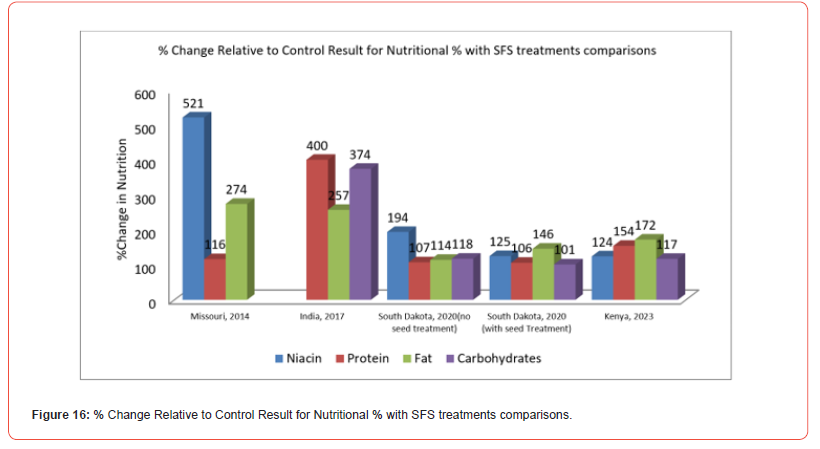
Soil Analysis comparison using SFS Treatments
Table 7 shown comparisons of the effects of SFS treatment in a golf course and saline wheat field
Table 7:Increase/Decrease Relative to Control for Soil Analysis comparison using SFS Treatments on a Golf Course and saline Wheat Field.
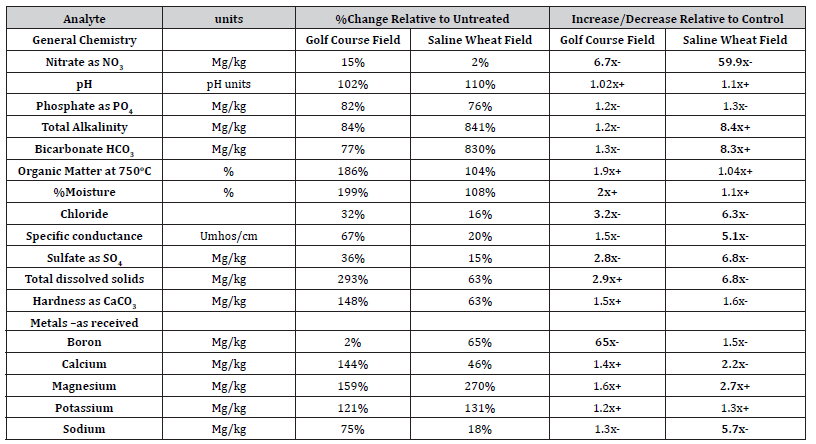
Conclusion
This paper is a culmination of 10+ years of research to find ways to improve carbon sequestration, climate resilience and increase the productivity of farms using nature-based solutions in non-pollutive, regenerative and commercially successful ways. We have demonstrated ways to improve Maize yield, nutritional density, and resiliency to climate change effects that are sustainable. Additionally, the crop nutritional analysis results show nutritional density of the raised maize crops that meet or exceed WHO Nutrition/Fortification standards [31].
This report is a comparison of 10 years of maize research carried out in three different farming systems globally including India, North America and Africa. Two studies were done in India in 2017 and 2018, three studies in the United States in 2014, 2020 and 2022 while in Africa (Kenya and Zambia) two studies were done in Kenya and Zambia in 2023. Salvation Farming Solutions (SFS) has developed a line of nature based, non-GMO cropping solutions (patents pending) focused on smallholder farmers designed to disrupt the global agricultural industry by improving water availability/quality, detoxifying and increasing soil fertility, extremely significantly improving crop production and improving the nutritional density of the food produced!
There is increased momentum in use of Nature based initiatives to store carbon in soils as a measure to mitigate climate change while researchers have shown that combining Organic inputs including nature-based solutions like SFS treatments with mineral fertilizer seems to be the most promising carbon sequester in agricultural soils.
It is worthy to note that maize planted with SFS solutions seemed resistant to pest infestations as compared to control groups. Additionally, in India Aflatoxin appeared on control corn and none appeared in the SFS treated groups. Based on the growth of the corn plants and increased silage benefits along with the nutritional density, not only is the corn nutritionally beneficial, but also the nutrient density is likely to be beneficial for the livestock being fed the silage. It is also be noted that in various areas where drought has been a factor, the moisture benefit in the soils treated with SFS have had significant drought resistance characteristics and have been seen in other crops such as wheat and cotton in other field trials in the US using SFS products [32].
Key findings of this research demonstrate that maize crop productivity can be significantly enhanced in soils that have not been intensively farmed most likely due to the biome vitality of the soil enhanced through nature-based solutions to improve moisture, nutrient availability, and stimulate carbon sequestration and nitrogen fixation. Soils that have been intensively farmed such as in the United States seem to be less productive on an acreto- acre comparative basis most likely due to non-regenerative approaches which are common for large scale farming. Naturebased agricultural solutions can provide small holder farmers significant financial benefits and provide consumers with more nutritious foods.
When looking at nutritional benefits associated with use of SFS products, significant increase in Niacin, Zinc and Iron was noted thus present a healthier pathway in addressing hidden hunger being experienced by farming communities in developing economies. Use of SFS products provides a better alternative for the food fortification initiatives which ensure natural bio-availabity of the essential nutrients naturally instead of using chemical-based bio fortification compounds [33].
We also understand the enormous variability in Soil conditions, Fertilizer use and yield among the different cropping systems and geographies. The application of the nature-based solutions such as SFS treatments in addressing climate change mitigation, soil health, farm production and productivity should take into account the differences.
Fertilizer use and crop yields are very low in developing countries especially Africa [34]. Application of SFS treatments have been shown to have potential in transforming the farming systems with a focus on smallholder farmers by improving water availability/quality, detoxifying and increasing soil fertility, significantly improving crop production and improving the nutritional density of the food produced.
According to Van Ittersum et al. [35], and Ten Berge et al. [36], given adequate production potential, increasing nutrient has the potential of increasing the availability of biomass which can be returned to the field to sequester carbon hence providing a positive feedback loop between crops and soils. Results from the studies across the three farming systems have demonstrated the potential of SFS treatments for carbon sequestration and also increasing the soil Nitrogen especially in the developing world setting where farms have not been intensively farmed. It is further noted that in regions where fertilizer use is high in cases of highly commercialized farms, increasing nutrient use efficient which results in reduction on N2O emissions is the pathway that can be employed as mitigation to climate change.
Use of nature-based solutions such as SFS products is key in establishing sustainable farming practice. Results from the studies in Zambia demonstrate the potential in building a resilient farming system in Sub Saharan Africa with potential to cope with challenges associated with climate change [37].
Support and Acknowledgement
The studies reported here is a result of enormous financial and human capital investments by various entities including the World Aquarium’s Conservation Foundation.
The Zambia study was made possible in part by the generous support of the American people through the United States Agency for International Development (USAID) via the LASER PULSE Program.
The contents are the responsibility of Salvation Farming Solutions LLC and do not necessarily reflect the views of USAID or the United States Government.
We would also like to acknowledge support from our partners, Stephen Chileshe, Nancy Fumpa, Frank Chikuma, and Kaluba Nkole of ZARI Kabwe station. The team from North Carolina A&T state university led by Prof. Godfrey Ejimakor, the study Co-Principal Investigator.
We also acknowledge the support of Abraham Eseme who managed the Kenya on farm study.
Conflict of Interest
No conflict of interest.
References
- FAO (2020c) Climate change: Unpacking the burden on food safety. Food safety and quality series 8: 176p.
- FAO (2014) Building a common vision for sustainable food and agriculture: Principles and Approaches. 56p.
- World Bank (2023) World Development Indicators.
- Dixon J, Garrity DP, Boffa JM, Williams TO, Amede T (2020) Farming Systems and Food Security in Africa: Priorities for Science and Policy under Global Change; Earthscan: London, UK.
- Foley JA, Ramankutty N, Brauman KA, Cassidy ES, Gerber JS, et al. (2011) Solutions for a cultivated planet. Nature 478: 337.
- Amede T, Konde AA, Muhinda JJ, Bigirwa G (2023) Sustainable Farming in Practice: Building Resilient and Profitable Smallholder Agricultural Systems in Sub-Saharan Africa. Sustainability 15(7): 5731.
- Cohen-Shacham E, Walters G, Janzen C, Maginnis S (2016) Nature-based Solutions to address global societal challenges.
- Miralles-Wilhelm F (2021) Nature-Based Solutions in Agriculture: Sustainable Management and Conservation of Land, Water, and Biodiversity. The United Nations Food and Agriculture Organization, and The Nature Conservancy.
- Iseman T, Miralles-Wilhelm F (2021) Nature-based solutions in agriculture – The case and pathway for adoption. Virginia. FAO and The Nature Conservancy, 53p.
- Abdelmagied M, Mpheshea M (2020) Ecosystem-based adaptation in the agriculture sector A nature-based solution (NbS) for building the resilience of the food and agriculture sector to climate change. Rome, FAO.
- Global Commission on Adaptation (GCA) (2019) Adapt Now: A Global Call for Leadership on Climate Resilience.
- Pinner D, Rogers M, Samandari H (2020) Addressing climate change in a post-pandemic world. McKinsey Quarterly.
- FOLU (2019) Growing Better: Ten Critical Transitions to Transform Food and Land Use. Food and Land Use Coalition.
- UNESCO (2018) Nature-based Solutions | United Nations Educational, Scientific and Cultural Organization.
- Seddon N, Chausson A, Berry P, Girardin CAJ, et al. (2020) Understanding the value and limits of Nature based Solutions to climate change and other global challenges. Philosophical Transactions of the Royal Society B: Biological Sciences 375(1794): 20190120.
- Sonnenschein L (2017) If we are what we Eat, how have Decreases in Nutritional Densities of Food Affected Health? Biomed J Sci & Tech Res 1(2): 1-2.
- Pearson CJ (2007) Regenerative, semi closed systems: A priority for twenty-first-century agriculture. BioScience 57: 409-418.
- HLPE (2019) Agroecological and Other Innovative Approaches for Sustainable Agriculture and Food Systems that Enhance Food Security and Nutrition; A report by the High Level Panel of Experts on Food Security and Nutrition of the Committee on World Food Security, Rome; FAO: Rome, Italy.
- Silici L (2014) Agroecology: What It Is and What It Has to Offer; IIED Issue Paper; IIED; FAO: London, UK.
- JUMA DW, WANG H, LI F (2014) Impacts of population growth and economic development on water quality of a lake: case study of Lake Victoria Kenya water. Environmental Science and Pollution Research 21: 5737-5746.
- A Rizzo, C Sarti, A Nardini, G Conte, F Masi, et al. (2023) Nature-based solutions for nutrient pollution control in European agricultural regions: A literature review. Ecological Engineering 186: 106772.
- UN-OCHA (2021) Global Humanitarian Overview 2021: United Nations Coordinated Support to People Affected by Disaster and Conflict. New York, NY: United Nations Office for the Coordination of Humanitarian Affairs (OCHA).
- Ankarfjard R, Subsol S, Harvey Williams F (2021) Nature-based Solutions: Key results and lessons learned from IFAD’s Adaptation for Smallholder Agriculture Programme, ASAP Technical Series (Rome: IFAD).
- Ebenso B, Otu A, Giusti A, Cousin P, Adetimirin V, et al. (2022) Nature-Based One Health Approaches to Urban Agriculture Can Deliver Food and Nutrition Security. Front Nutr 9: 773746.
- De Winne J, Peersman G (2021) The adverse consequences of global harvest and weather disruptions on economic activity. Nat Clim Change 11(8): 665–72.
- ZARI (Zambia Agricultural Research Institute) (2002) Maize production guide. In: Kaitisha GC, Gondwe P, Mukwavi MV, Kaula GM (Eds.), Prepared by the Soils and Crops Research Branch, Ministry of Agriculture and Cooperatives, Mt. Makulu, Zambia.
- Burke WJ, Jayne TS, Black JR (2017) Factors explaining the low and variable profitability of fertilizer application to maize in Zambia. Agricultural economics 48(1): 115-126.
- Okalebo JR, Gathua KW, Woomer PL (2002) Laboratory Methods for Soil and Plant Analysis: A Working Manual. TSBF, Nairobi.
- JG Ryan, J Estefan, A Rashid (2001) Soil and Plant Analysis Laboratory Manual. International Center for Agricultural Research in the Dry Areas (ICARDA), Islamabad, Pakistan.
- Mwai JM, Oketch FA, Sila DN, Kiage BN, Abuga D, et al. (2021) Compliance of Maize Meal to Food Safety And Food Fortification Standards At Market Level In Kenya. Journal Of Agriculture, Science and Technology 20(3).
- Hijbeek R, van Loon MP, van Ittersum MK (2019) Fertiliser use and soil carbon sequestration: opportunities and trade-offs. CCAFS Working Paper no. 264. Wageningen, the Netherlands: CGIAR Research Program on Climate Change, Agriculture and Food Security (CCAFS).
- Leonard Sonnenschein and Etyang Tiberious Brian (2019) Dealing with the Sins of the Past and Work towards a Nature-Based Future: New Innovative Technologies for Sustainable Agriculture. World Journal of Agriculture and Soil Science 2(1): 1-7.
- Leonard Sonnenschein, Kenneth Masuki, Osia Odula, Etyang Tiberious Brian (2019) Soil Restoration: Drought Resistance, Soil Health Improvement, Toxin Sequestration and Worms. World J Agri & Soil Sci 3(5): 1-4.
- FAO (2019) FAOSTAT Database collections. Production/Crops and Resource/Fertilizer, Rome.
- Ten Berge HFM, Hijbeek R, Van Loon MP, Rurinda J, Tesfaye K, et al. (2019) Maize crop nutrient input requirements for food security in sub-Saharan Africa. Global Food Security 23: 9-21.
- Van Ittersum MK, van Bussel LGJ, Wolf J, Grassini P, van Wart J, et al. (2016) Can sub-Saharan Africa feed itself? PNAS, 113: 14964-14969.
- (2023) Three Things to Know About Nature-Based Solutions for Agriculture.
-
Leonard Sonnenschein* and Tiberious Etyang. Improving Carbon Sequestration, Climate Resilience and Increasing the Productivity of Farms using Nature Based Solutions: The Case of Salvation Farming Solutions. World J Agri & Soil Sci. 9(1): 2023. WJASS.MS.ID.000703.
-
Carbon sequestration, Climate resilience, Nature based solutions, Farm productivity, Soil health, Food systems transformation, Nutrition and human health, Global population growth, Food security, Regenerative farming, Sustainable farm families, Soil-moisture availability, Soil quality, Water quality
-

This work is licensed under a Creative Commons Attribution-NonCommercial 4.0 International License.






